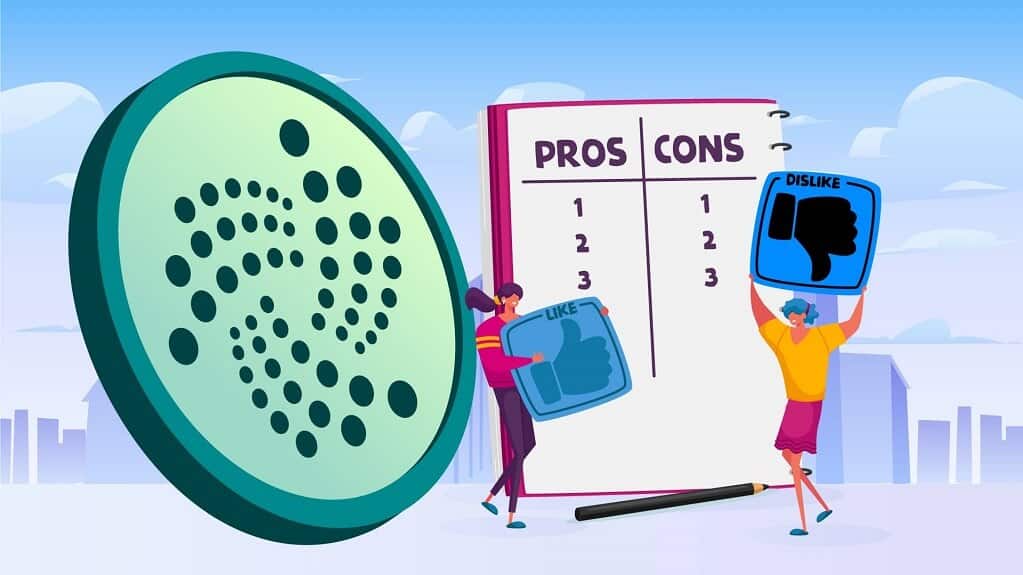What are the Disadvantages of IOTA?

The Internet of Things, abbreviated as IoT, is all about providing cost-effective sensors for collecting data about our devices and their ecosystems. The data gathered and made available to the public over the internet with just a few clicks of a button. So, what is IOTA?
IOTA is the cryptocurrency as well as the organization behind IoT. Unlike the traditional blockchain or public distribution ledgers, IoT uses the innovative Tangle blockchain. IOTA is the crypto powering the Tangle blockchain.
IoT’s underlying principle is gathering data from our devices and the world around us to make this data available on the internet. For achieving this result, the network uses cheap data-collecting sensors. All the data collected by these sensors and the IOTA transactions are stored on the Tangle distributed ledger.
Although what may sound like a breakthrough technology despite very few advantages like the lack of transaction fees, IOTA has several limitations. But before getting into IOTA predictions of 2021 and the drawbacks of cryptocurrency, let’s understand its blockchain.
What is Tangle?
As a protocol for storing the sensors collected data and the underlying blockchain for recording IOTA transactions, Tangle is a completely different public distributed ledger from traditional blockchain technology. DAG or Directed Acyclic Graph is the driving factor that makes Tangle an altogether different kind of blockchain.
Simply put, Tangle blockchain is the Directed Acyclic Graph consensus algorithm. For example: For sending an IOTA transaction, the user must validate two previous transactions that were received. Also, known as the two-for-one or pay-it-forward consensus makes for reliable validation of transactions.
Disadvantages of IOTA?
The more the devices confirming the transactions, the stronger is the transaction’s validity. Based on this theory, IOTA prediction points to a potential adoption into the mainstream. However, there are several disadvantages or limitations, which are as follows:
Unproven Tangle Technology
Validation of the transaction occurs in an acyclic manner, unlike the traditional blockchain, which is a major disadvantage. Consistency in validating transactions is a big question that Tangle fails to answer, and thus, limiting the potential of the IOTA cryptocurrency.
The Issue of Centralization
An IOTA transaction is confirmed by a node, which is then visible to the other nodes for further validation. The node which initially validates the transaction is the coordinator in control of the validation process. And this, in turn, makes Tangle a centralized blockchain. Decentralization is the crux of blockchain technology employed by other cryptos like Bitcoin, popularizing the currencies. Thus, the centralization element is yet another drawback.
Lack of Smart Contracts
Tangle and IOTA are unsuitable for developing DApps due to the lack of smart contracts. Moreover, the blockchain is somewhat centralized, which further makes it impossible to create dApps using the Tangle technology.
Security is Dependent on PoW
Proof of Work (PoW) ensures secure transaction and validation. However, it is yet another drawback of the Tangle system due to the costs involved. The coordinator node requires a ‘work chip’ as it is essential for PoW. Nevertheless, the work chip is not originally installed on the IoT devices, adding to the additional cost. Also, the electricity consumption for the PoW consensus is quite high. The bottom line is although IOTA transactions are free of cost, the validation charges do apply.
Conclusion
IOTA and its underlying Tangle technology are innovative concepts with their own sets of benefits and drawbacks. Thus, before making a sound decision on whether to invest in this innovative cryptocurrency or not, one has to have a better understanding of the crypto’s benefits and limitations.